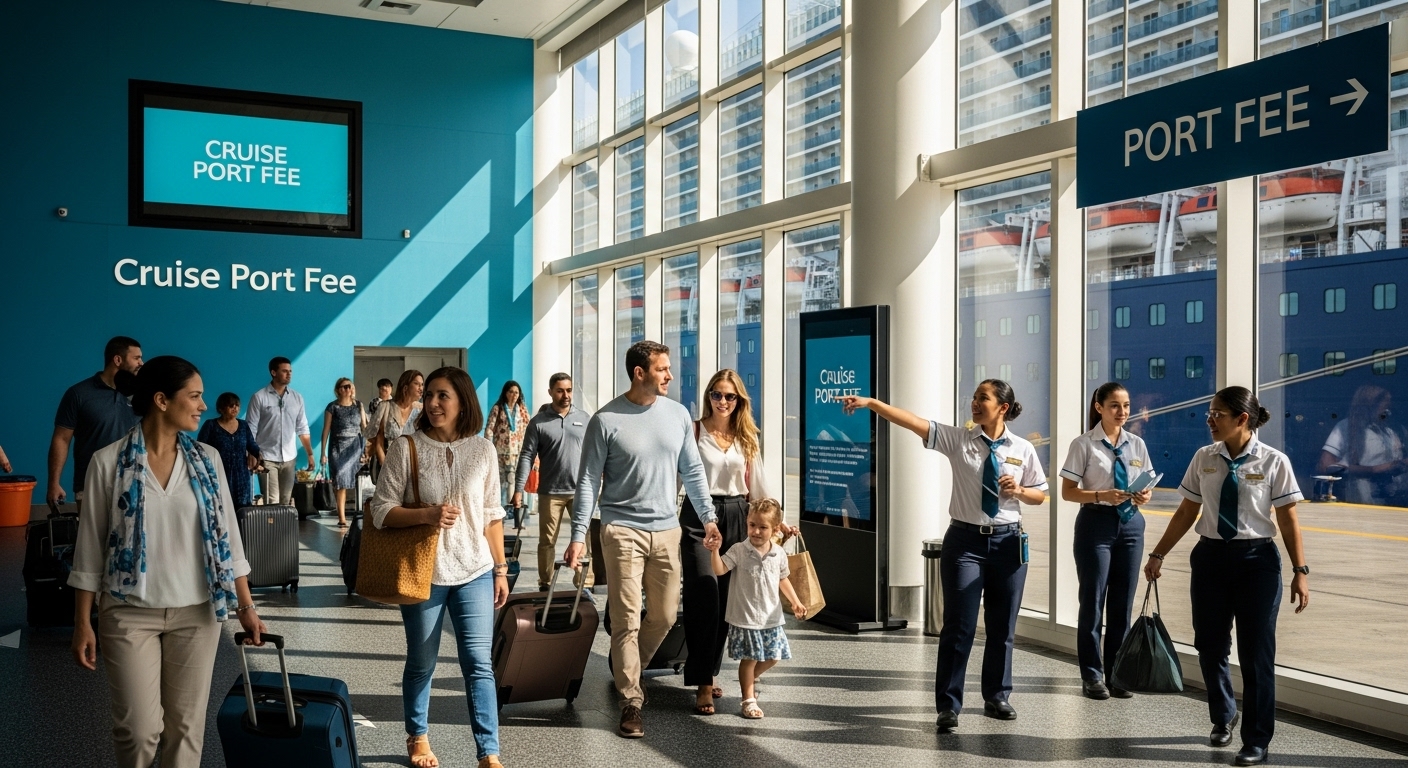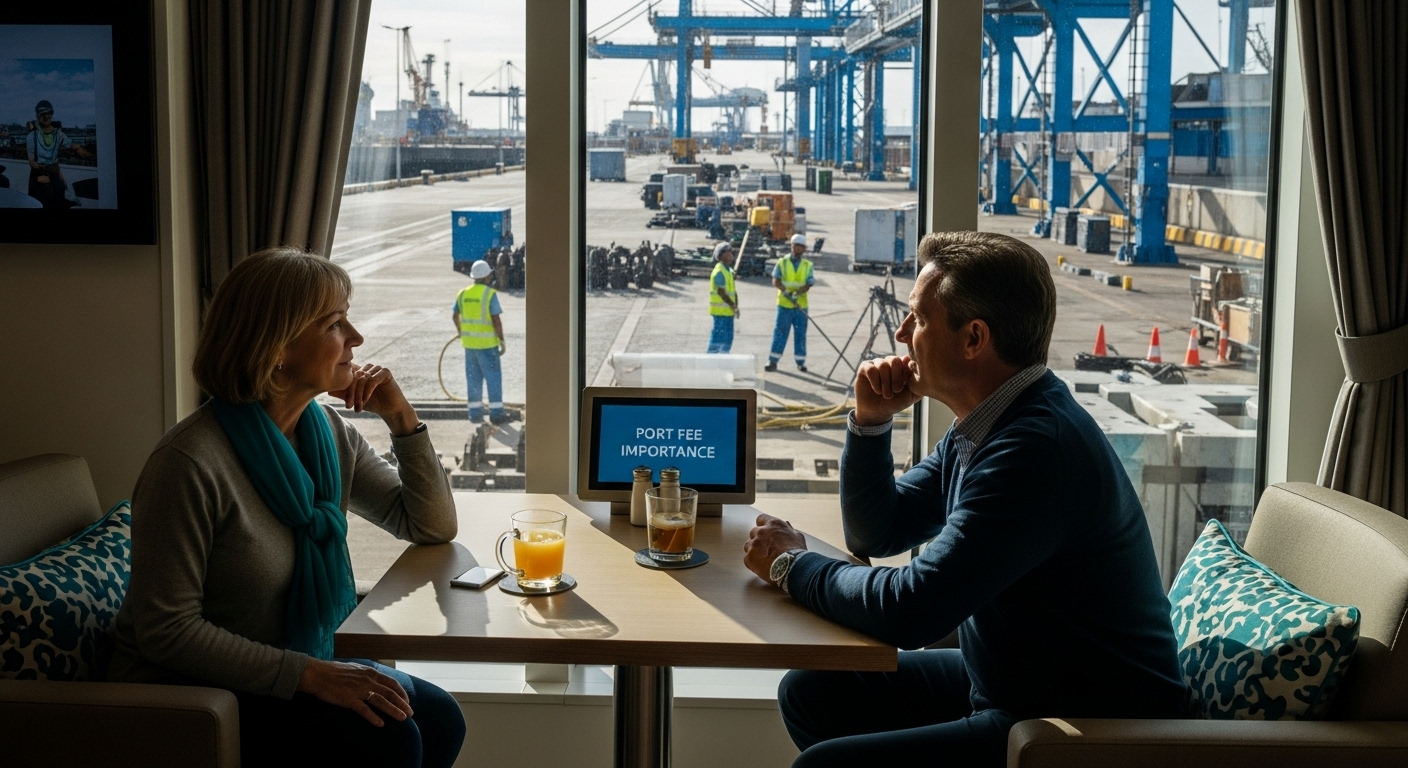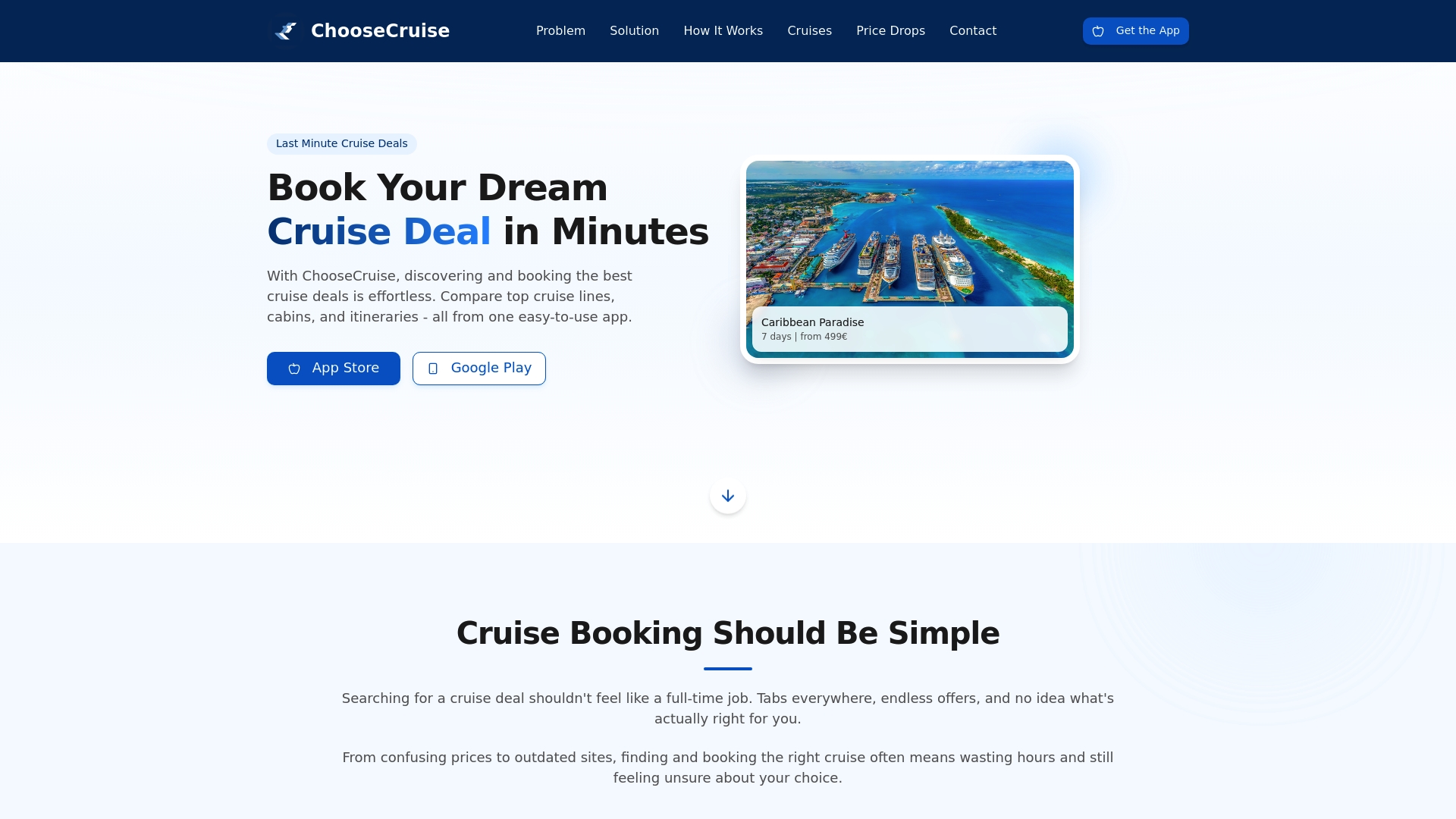What is Cruise Port Fee? Understanding Its Importance

Cruise vacations promise unforgettable experiences and seamless travel between stunning destinations. But most travelers never realize that cruise port fees often make up 15 to 20 percent of your total ticket cost. You might think these are just extra charges tacked onto your bill. The reality is these fees are the secret engine powering everything from high-tech terminals to emergency services and even environmental protection programs.
Table of Contents
- Defining Cruise Port Fee: What Is It?
- The Importance of Cruise Port Fees for Travelers
- How Cruise Port Fees Work: Breakdown and Usage
- Key Concepts Behind Cruise Port Fees
- Factors Influencing Cruise Port Fee Rates
Quick Summary
| Takeaway | Explanation |
|---|---|
| Cruise port fees are mandatory charges. | These fees are essential for port operations and services during cruise ship docking. |
| Fees are calculated based on specific factors. | Key determinants include ship size, duration of stay, and required services. |
| Port fees support local economies and tourism. | They fund essential infrastructure and services that enhance traveler experiences. |
| Travelers indirectly pay these fees through ticket prices. | Cruise lines factor port fees into cruise ticket costs, impacting overall pricing. |
| Understanding port fees enhances travel appreciation. | Recognizing their significance helps travelers value the investment in tourism infrastructure. |
Defining Cruise Port Fee: What is it?
A cruise port fee represents a mandatory financial charge imposed by ports on cruise ships for utilizing their infrastructure, facilities, and services during vessel docking and passenger operations. These fees are essential administrative and operational costs that ensure smooth maritime logistics and port management.
Understanding Port Fee Structures
Cruise port fees are comprehensive charges that cover multiple aspects of maritime operations.
They are not simple one-dimensional expenses but complex financial mechanisms designed to support port infrastructure maintenance and development. Ports invest significant resources in creating safe, efficient environments for cruise ships, which means these fees contribute directly to maritime safety, passenger experience, and regional economic sustainability.
![]()
Key Components of Cruise Port Fees
- Docking infrastructure maintenance
- Security personnel and equipment costs
- Passenger terminal operational expenses
- Navigation channel maintenance
- Environmental compliance and monitoring
Economic and Operational Significance
Ports strategically calculate these fees based on multiple factors including ship size, passenger capacity, duration of stay, and specific service requirements. According to UK Government Maritime Guidelines, port fees are critical mechanisms for recovering operational costs and reinvesting in maritime infrastructure.
These fees are typically not optional and are built into the overall cruise pricing structure. Cruise lines factor port fees into their ticket prices, which means passengers indirectly contribute to maintaining robust maritime ecosystems. The charges ensure that ports can continuously upgrade facilities, implement advanced security protocols, and provide seamless travel experiences for international travelers.
By understanding cruise port fees, travelers gain insight into the complex operational landscape that enables their maritime adventures, recognizing that these charges represent more than just a financial transaction but a critical investment in global maritime infrastructure and passenger safety.
The Importance of Cruise Port Fees for Travelers
Travelers might view cruise port fees as an additional expense, but these charges play a crucial role in enhancing the overall cruise experience and supporting sustainable maritime tourism. Understanding their significance helps passengers appreciate the complex infrastructure that enables seamless travel.
Beyond Basic Transportation
Cruise port fees are far more than simple administrative charges. They represent strategic investments in passenger comfort, safety, and destination quality. These fees fund critical services and infrastructure that directly impact traveler experiences, from state-of-the-art passenger terminals to advanced security systems and environmental protection mechanisms.
The following table highlights the critical services and benefits cruise port fees provide for travelers, helping clarify their operational impact beyond basic transportation costs.
| Service/Benefit | Impact on Travelers |
|---|---|
| Advanced Passenger Terminal Facilities | Enhances comfort and efficiency during embarkation |
| Security Screening and Technologies | Improves safety and security for all passengers |
| Accessibility and Special Needs Support | Ensures inclusive and accessible travel experiences |
| Emergency Response and Medical Support | Provides readiness and peace of mind in emergencies |
| Sustainable Tourism Initiatives | Helps preserve destinations for future travel |
| Economic Support for Local Communities | Boosts tourism and regional economic development |
Critical Services Supported by Port Fees
- Comprehensive passenger terminal facilities
- Advanced security screening technologies
- Accessibility support for travelers with special needs
- Emergency response and medical support infrastructure
- Sustainable tourism development programs
Economic and Travel Experience Impact
According to Cruise Lines International Association, cruise port fees contribute significantly to local economies and tourism development. These fees enable ports to maintain high-quality facilities, support local communities, and create memorable experiences for international travelers.
Ports use these funds to continuously upgrade passenger facilities, implement cutting-edge technologies, and ensure travelers have smooth, secure, and comfortable journeys. The fees effectively transform basic transportation infrastructure into world-class travel environments. Discover more cruise travel insights that can help you understand the intricate details of maritime travel.
For travelers, understanding port fees means recognizing the extensive behind-the-scenes work that makes modern cruise experiences possible. These charges represent a collective investment in global maritime tourism, supporting not just transportation, but entire ecosystems of travel, local economic development, and international connectivity.

How Cruise Port Fees Work: Breakdown and Usage
Cruise port fees represent a complex financial mechanism that ensures seamless maritime operations and sustainable port infrastructure. Understanding their intricate calculation and allocation helps travelers appreciate the comprehensive services these fees support.
Fee Calculation Mechanisms
Ports develop sophisticated pricing models that consider multiple variables when determining cruise port fees. These calculations are not arbitrary but strategic assessments designed to recover operational costs while maintaining competitive pricing for cruise lines and passengers.
To help travelers understand how cruise port fees are calculated, the following table organizes the key factors that influence the final fee amount set by ports.
| Influencing Factor | Description |
|---|---|
| Ship Size and Tonnage | Larger ships incur higher fees due to space and resource use |
| Total Passenger Capacity | More passengers increase operational demands |
| Duration of Port Stay | Longer stays require more resources and security |
| Frequency of Vessel Visits | Frequent visits may qualify for different pricing |
| Required Specialized Services | Extra services, like medical or accessibility, add to fees |
| Environmental Impact Requirements | Sustainability initiatives can influence overall fees |
Key Factors Influencing Port Fee Calculations
- Ship size and total passenger capacity
- Duration of port stay
- Frequency of vessel visits
- Required specialized services
- Environmental impact and sustainability requirements
Financial Allocation and Infrastructure Investment
According to UK Department for Transport Maritime Statistics, port fees are meticulously allocated across various critical operational areas. These funds support not just immediate port services but long-term maritime infrastructure development. Explore cruise booking strategies to understand how these fees integrate into overall travel planning.
The allocation typically encompasses infrastructure maintenance, security systems, passenger facilities, navigation channel upkeep, and environmental compliance programs. Ports strategically reinvest these revenues to enhance maritime safety, improve passenger experiences, and support regional economic development.
For travelers, understanding port fees means recognizing them as more than just an additional charge. These fees represent a comprehensive investment in creating safe, efficient, and technologically advanced maritime travel ecosystems that benefit passengers, local communities, and the global tourism industry.
Key Concepts Behind Cruise Port Fees
Cruise port fees represent a sophisticated financial ecosystem that goes beyond simple monetary transactions. These fees encapsulate complex maritime management principles, technological infrastructure requirements, and strategic economic development goals that support global maritime tourism.
Foundational Economic Principles
At their core, cruise port fees reflect advanced economic models that balance operational costs, infrastructure investment, and sustainable tourism development. These fees are not arbitrary charges but carefully calculated mechanisms designed to support comprehensive maritime ecosystems.
Core Economic Considerations in Port Fee Structures
- Recovery of direct operational expenses
- Long-term infrastructure development funding
- Sustainable maritime ecosystem maintenance
- Regional economic development support
- Technological infrastructure investment
Technological and Regulatory Frameworks
According to UK Department for Transport Maritime Statistics, port fees play a critical role in maintaining advanced maritime infrastructure. These fees fund complex technological systems that ensure passenger safety, port efficiency, and regulatory compliance. Check out our cruise booking tips to understand how these intricate systems impact your travel experience.
The regulatory landscape surrounding port fees involves multiple stakeholders, including local governments, maritime authorities, cruise lines, and international transportation regulatory bodies. These fees represent a collaborative approach to managing maritime resources, balancing economic sustainability with passenger experience and environmental considerations.
Understanding cruise port fees means recognizing them as sophisticated financial instruments that support not just immediate port operations, but broader goals of sustainable global maritime tourism development. They are investments in infrastructure, technology, safety, and regional economic growth.
Factors Influencing Cruise Port Fee Rates
Cruise port fees are dynamic financial mechanisms with complex calculation processes influenced by numerous interconnected factors. Understanding these variables helps travelers and industry professionals comprehend the nuanced pricing strategies that determine maritime operational costs.
Vessel and Passenger Characteristics
The primary determinants of cruise port fees center around the specific attributes of individual cruise vessels and their passenger demographics. Ports develop sophisticated assessment models that consider multiple quantitative and qualitative parameters to establish precise fee structures.
Key Vessel Characteristics Affecting Port Fees
- Gross tonnage and physical ship dimensions
- Total passenger capacity
- Frequency of port visits
- Length of vessel stay
- Specialized service requirements
Economic and Infrastructural Considerations
According to Highland Council Maritime Economic Report, port fees reflect complex economic strategies beyond simple cost recovery. These fees incorporate broader considerations of regional economic development, infrastructure maintenance, and sustainable tourism management. Explore exciting cruise destinations to understand how different ports approach fee calculations.
Additionally, ports consider geopolitical factors, regional tourism strategies, competitive positioning, and long-term infrastructure investment requirements when establishing their fee structures. Environmental regulations, technological upgrade costs, and regional economic goals play significant roles in determining these intricate pricing mechanisms.
Ultimately, cruise port fees represent a sophisticated financial instrument that balances immediate operational needs with strategic long-term maritime infrastructure development, reflecting the complex ecosystem of global maritime tourism.
Book With Confidence: Simplifying Cruise Port Fees and Smart Trip Planning
Understanding cruise port fees can leave travelers feeling frustrated and unsure, especially with so many factors like ship size, passenger capacity, and infrastructure costs shaping the final price. Too often, travelers end up overwhelmed by complex fee structures and spend hours comparing confusing cruise options on outdated websites. ChooseCruise is designed for digital-first adventurers who want cruise planning to be easy, transparent, and genuinely rewarding.

Why keep feeling uncertain about hidden charges and missed experiences? Visit ChooseCruise right now and discover a smarter way to book your next cruise. With our AI-powered recommendations, real-time price tracking, and simple booking process, you can navigate even tricky topics like port fees with total confidence. Check out more cruise booking tips and travel insights so you always make the best cruise decision for your needs. Start your effortless journey with ChooseCruise today and turn industry jargon into savings and unforgettable memories.
Frequently Asked Questions
What is a cruise port fee?
A cruise port fee is a mandatory charge imposed by ports on cruise ships for using their infrastructure and services during docking and passenger operations.
What do cruise port fees cover?
Cruise port fees cover various aspects of maritime operations including docking infrastructure maintenance, security personnel and equipment costs, passenger terminal expenses, navigation channel upkeep, and environmental compliance measures.
How are cruise port fees calculated?
Cruise port fees are calculated based on multiple factors such as the ship’s size, passenger capacity, duration of stay, frequency of visits, and specific service requirements.
Why are cruise port fees important for travelers?
Cruise port fees play a crucial role in enhancing the cruise experience by funding essential services and infrastructure, ensuring passenger safety and comfort, and supporting local economies through sustainable tourism development.
Recommended
Related reading
7 Smart Ways to Save on Cruises for Modern Travelers
Discover 7 smart ways to save on cruises with easy, practical tips designed for today’s digital cruise travelers. Learn to maximize value and minimize costs.
Understanding Why Choose River Cruises for Travel Fun
Discover why choose river cruises as your next adventure. Explore their benefits, unique experiences, and how they enhance travel enjoyment.
Understanding the Best Cruise Lines for Beginners
Discover the best cruise lines for beginners, understanding what they offer and why they matter for first-time cruisers.